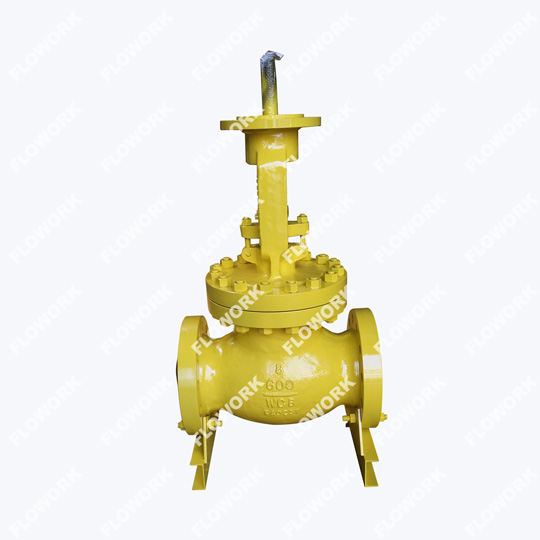
1、You are in restricted area and need password. Please Contact us to obtain documents.
2、PasswordIf you have any questions about quotation or cooperation, please feel free to send us inquiry. Inquiry us
| Size: | 2"-24" |
| Pressure: | 150LB-2500LB |
| Body Material: | WCB, WC6, WC9, CF8, CF8M, CF3, CF3M, CN7M, LC1, LC2, LC3, LCB, LCC, Monel, 20# Alloys, 4A, 5A, C95800, C95500, A105, F304, F304L, F316, F316L, LF1, LF2, LF3, LF9, F51, F53, F11, F22, etc. |
| Seal Material: | STELLITE, 13Cr, SS304, SS316, etc. |
| Connection Type: | Flanged, Butt Welded, Socket Welded, NPT |
| Operation: | Handwheel, gear operated, pneumatic, motorized |
| Face to Face Dimension: | ASME B16.10 |
| Flange End Dimension: | ASME B16.5 |
| Butt Welded Dimension: | ASME B16.25 |
| Design and Manufacture: | BS1873,API623 |
| Test Standard: | API 598,API 6FA, ISO 15848-1-2 |
Design Standard: BS1873, API 602, API 623, DIN3356
Function: cutting off, regulating and throttling medium
The closure part is a plug or disc that connected with stem.
Available with straight type, Y type, angle type, stop type, bellow sealed type, etc.
Disc Type: swivel type, loose type, plug type, parabolic type, needle type, flat type, etc.
Bonnet Type: Bolted Bonnet, Pressure Seal Bonnet, Welded Bonnet, etc.
Function: cutting off, regulating and throttling
Only one-way flow of the medium is allowed.
To hydrotest a globe valve, you need to follow these steps:
1. Close the valve: Close the globe valve to prevent water from flowing through it during the hydrotest. api 6d ball valve
2. Connect the test equipment: Connect the hydrotest equipment to the valve. This typically involves attaching a pressure gauge and a hose to the valve.
3. Fill the system: Fill the system with water until it is completely full. This ensures that there is no air trapped in the system.
4. Pressurize the system: Use the hydrotest equipment to pressurize the system to the desired test pressure. The test pressure is typically 1.5 times the maximum working pressure of the valve.
5. Monitor the pressure: Monitor the pressure gauge to ensure that the test pressure is maintained for the required duration of the test. The duration of the test is typically specified by the valve manufacturer or by industry standards. forged ball valve
6. Inspect the valve: After the test is complete, inspect the valve for any signs of leakage or damage. If the valve passes the hydrotest, it can be put into service. If the valve fails the hydrotest, it must be repaired or replaced before it can be used.
It is important to note that the hydrotest procedure may vary depending on the specific valve and the requirements of the application. Always refer to the valve manufacturer's instructions and industry standards for guidance on how to properly hydrotest a globe valve. carbon steel gate valves
The trim of a globe valve refers to the internal components of the valve that come into contact with the fluid being controlled. These components include the valve seat, valve disk or plug, stem, and other parts that are used to regulate the flow of fluid through the valve. high temperature gate valves
The trim of a globe valve is designed to provide precise control of the flow rate and to ensure a tight shut-off when the valve is closed. The valve seat is typically made of a hard, wear-resistant material such as stainless steel or ceramic, while the valve disk or plug is made of a softer material such as rubber or Teflon. The stem is usually made of a corrosion-resistant material such as stainless steel or bronze.
The specific design of the trim can vary depending on the application and the type of fluid being controlled. For example, in high-temperature or high-pressure applications, the trim may be designed to withstand extreme conditions and prevent leakage. In corrosive environments, the trim may be made of materials that are resistant to corrosion, low temperature ball valves.
In summary, the trim of a globe valve is the internal components of the valve that are used to regulate the flow of fluid. The design of the trim can vary depending on the application and the type of fluid being controlled.
A globe valve is typically used in applications where precise flow control is required. Here are some situations where a globe valve may be used:
1. Throttling or regulating flow: Globe valves are commonly used when you need to control the flow rate of a fluid. They provide excellent throttling capabilities, allowing for precise adjustment of the flow.
2. High-pressure systems: Globe valves are suitable for high-pressure applications due to their robust construction and ability to withstand high pressures, api602 forged gate valve.
3. Steam systems: Globe valves are commonly used in steam systems, as they can handle high temperatures and pressures associated with steam.
4. Isolation: Globe valves can also be used for isolation purposes, where the valve is fully open or fully closed to stop the flow completely.
5. Control systems: Globe valves are often used in control systems, where they can be operated by an actuator or control mechanism to regulate the flow based on specific parameters.
It's important to consider the specific requirements of your application and consult with an engineer or valve specialist to determine if a globe valve is the right choice for your needs.
Send us a message if you have any questions or request a quote.

A reply from our experts within 24 hours

The latest detailed product catalugue

One-stop service for your project